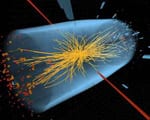The news web site redOrbit has covered the SMU Physics Department’s recent supernovae discoveries. The article, “Astronomers Discover White Dwarf Supernovae,” was published Feb. 27. Light from two massive stars that exploded hundreds of millions of years ago recently reached Earth, and each event was identified as a supernova by SMU graduate students in the physics department.
Both supernovae were spotted with the Robotic Optical Transient Search Experiment‘s robotic telescope ROTSE3b, which is now operated by SMU graduate students. ROTSE3b is at the McDonald Observatory in the Davis Mountains of West Texas near Fort Davis.
The Central Bureau for Astronomical Telegrams of the International Astronomical Union officially designated the discoveries as Supernova 2013X and Supernova 2012ha.
Ferrante and Dhungana made both discoveries as part of an international collaboration of physicists from nine universities. Everest and Sherpa were discovered with a fully automated, remotely controlled robotic telescope at the University of Texas’ McDonald Observatory. The discovery is a first for the SMU collaboration members.
EXCERPT:
By Lee Rannals
redOrbit.com
White dwarf supernovae that occurred millions of years ago have popped up in the Virgo Cluster galaxy and part of the sky labelled as “anonymous.”Southern Methodist University (SMU) researchers say they’ve confirmed two bright stars that showed up in our skies in February and November are supernovae. Supernovae are the result of stars that have reached the end of their life, resulting in a large explosion that can consume anything in its path.
In November, Farley Ferrante, a graduate student at SMU, made the initial observation of a supernova, Supernova 2012ha or “Sherpa,” that derived from the Virgo constellation, about 230 million light years away. Another supernova, Supernova 2013X or “Everest,” was discovered on February 6, sitting 450 million years away in a part of the sky labeled “animus” near the faint constellation Canes Venatici.
“Everest and Sherpa aren’t noteworthy for being the youngest, oldest, closest, furthest or biggest supernovae ever observed,” Ferrante said. “But both, like other supernovae of their kind, are important because they provide us with information for further science.”
Both supernovae are considered Type 1a, which are the result of white dwarf explosions. A white dwarf star has a mass comparable to that of the Sun and its core is a comparable size to that of the Earth. According to Robert Kehoe, physics professor and leader of the SMU astronomy team in the SMU Department of Physics, a teaspoon of a white dwarf star would weigh about as much as Mount Everest.
When a white dwarf heads towards the end of its life, it grows to about one and a half times the size of the sun and eventually collapses and explodes, resulting in a Type 1a supernova.
“We call these Type 1a supernovae standard candles,” Ferrante said. “Since Type 1a supernovae begin from this standard process, their intrinsic brightness is very similar. So they become a device by which scientists can measure cosmic distance. From Earth, we measure the light intensity of the exploded star. As star distances from Earth increase, their brilliance diminishes.”
Follow SMUResearch.com on Twitter.
For more information, www.smuresearch.com.
SMU is a nationally ranked private university in Dallas founded 100 years ago. Today, SMU enrolls nearly 11,000 students who benefit from the academic opportunities and international reach of seven degree-granting schools. For more information see www.smu.edu.
SMU has an uplink facility located on campus for live TV, radio, or online interviews. To speak with an SMU expert or book an SMU guest in the studio, call SMU News & Communications at 214-768-7650.


 Hiding in plain sight: How invisibility saved New Mexico’s Jicarilla Apache
Hiding in plain sight: How invisibility saved New Mexico’s Jicarilla Apache Study finds Jurassic ecosystems were similar to modern: Animals flourish among lush plants
Study finds Jurassic ecosystems were similar to modern: Animals flourish among lush plants SMU contributes fossils, expertise to new Perot Museum in ongoing scientific collaboration
SMU contributes fossils, expertise to new Perot Museum in ongoing scientific collaboration 100 million-year-old coelacanth discovered in Texas is new fish species from Cretaceous
100 million-year-old coelacanth discovered in Texas is new fish species from Cretaceous Academic achievement improved among students active in structured after-school programs
Academic achievement improved among students active in structured after-school programs Texas frontier scientists who uncovered state’s fossil history had role in epic Bone Wars
Texas frontier scientists who uncovered state’s fossil history had role in epic Bone Wars
 Ancient tree-ring records from southwest U.S. suggest today’s megafires are truly unusual
Ancient tree-ring records from southwest U.S. suggest today’s megafires are truly unusual Human diabetes has new research tool: Overfed fruit flies that develop insulin resistance
Human diabetes has new research tool: Overfed fruit flies that develop insulin resistance Middle school boys who are reluctant readers value reading more after using e-readers
Middle school boys who are reluctant readers value reading more after using e-readers
